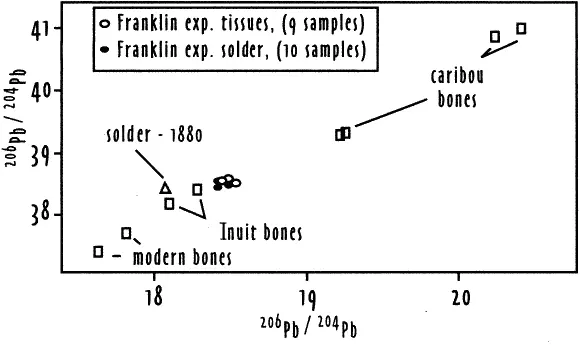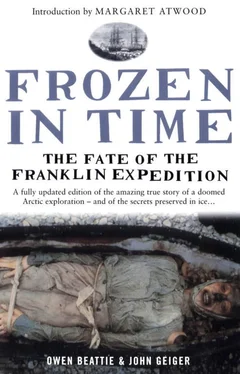Examination of preserved soft tissues and previously analyzed hair excluded the possibility that the lead exposure was simply a product of non-expedition factors, such as the environment of nineteenth-century industrial Britain. While the three crewmen died early on, within only seven to eleven months of sailing, sufficient time had elapsed to have eliminated most lead absorbed into the soft tissues before their departure. Lead resides in different body tissues for different periods of time after cessation of exposure. In the case of soft tissues, half of the lead present in an organ or tissue would have been eliminated in approximately twenty-one to forty days, with levels continuing to decline at a predictable rate. It is clear that the source of lead exposure originated not from factors or conditions encountered in England, but from those encountered aboard the discovery vessels themselves—aboard the Erebus and Terror. Here, too, contemporary scientific methods provide confirmation.
The tissues and solder were subjected to lead isotope ratio analysis, a means of “fingerprinting” the source of lead. The results indicated that the lead in the tissues was identical to that in the solder used in the food cans. These findings, published in the journal Nature, in 1990, concluded that the lead contamination came not from a variety of sources, but, without exception, from a single European geological location. Had the body lead resulted from chronic personal exposure to a variety of local and environmental sources before the crews’ embarkation, or even afterward, it is unreasonable to suppose that all the individuals would have demonstrated the same isotopic ratios. Unless the sampled sailors had literally lived under the same roof (a possibility discounted by British Admiralty records that show the crews were drawn from regions throughout the United Kingdom), the ratios of lead found in the tissues of each crew member would have been skewed differently. What’s more, while representing short-term exposure, the lead in the soft tissues was indistinguishable from lead in the bones. This evidence confirms that the lead stored in the bones of crew members before the expedition was swamped by the subsequent massive exposure resulting from the solder in the tins. There is no question of the source of the lead found in the bodies of Franklin’s men: it came from the tinned foods. The devastating impact on their health followed.

Diagrammatic representation of the lead isotope analysis.
Furthermore, research conducted on skeletal remains discovered at a previously unrecorded site discovered on King William Island in 1992 served to provide independent corroboration of Beattie’s research. The results of this new investigation, published by Anne Keenleyside et al in the Journal of Archaeological Science in 1996, stated that the “pattern of distribution of lead between bones indicates excessive intake of lead during the period of the expedition. Predictions of blood lead levels based on the measured bone lead concentrations, suggest that the current upper limit for occupational exposure recommended to prevent neurological changes was exceeded.” In 1997, a second publication arising from this research stated that “elevated lead levels in the remains are consistent with previous measurements and support the conclusions of Beattie and colleagues that lead poisoning had greatly debilitated the men by this point.”
Tinned foods came into widespread use among the general population by the late 1800s, becoming “almost a necessity,” and this popularity was mirrored by a dawning sense of the danger posed by the use of solder containing lead. These suspicions are recorded in the medical literature of the time. Documented instances of “metallic poisoning,” or lead poisoning, attributed to consumption of tinned foods, began to appear in the 1880s, and reference is made to the common complaint regarding drops or fragments of solder found mixed with the food contents within the tins. The Medical News in 1883 warned: “In cases of obscure nervous affections look out for lead-poisoning, and bear in mind the use of canned food as a source of such poisoning.” Physicians started to raise questions as to the desirability of tinning as a means of food preservation. Changes to the design of food cans were subsequently introduced, addressing the most obvious lead-contamination sources, but not before the world’s most prestigious medical journal, The Lancet, asked why bottles were not substituted for tins. The answer surely lay with an industry that had an enormous capital stake in the trade, and the jobs associated with it. Nor are the serious consequences of lead relegated to the nineteenth century. Only in recent decades has lead been removed from house paints, gasoline and food tins (though tinned goods and lead-glazed ceramics in developing countries continue to be problematic); as well, drinking water is monitored to identify and manage the hazard.
Microbiological research into Hartnell and Braine also produced another curious, perhaps ominous, discovery. Not only have bacterial strains of the genus Clostridium survived the prolonged period of freezing, but some of the strains have shown resistance to modern antibiotics, a remarkable characteristic considering that the bacteria originated nearly a century before the development of antibiotics. It has been suggested that strains of bacteria more tolerant of pollutants can also show resistance to antibiotics. Medical researchers are only beginning to investigate the significance and implications of this evidence, especially in relation to the role of environmental pollutants in exacerbating the development of such resistance. There is a certain irony in the possibility that men who lived during the reign of Victoria should be the ones to alert scientists to such an insidious effect of the poison, lead, in our own time.
It is certainly not easy—and for some, doubtless impossible—to entertain the notion that so basic an instrument of human convenience as a tin can could have been a major factor in the loss of the Franklin expedition. From a purely emotional standpoint, it should have been anything else. If rigid adherence to conventional interpretations of the disaster is not to be followed, with scurvy, starvation, stress and hypothermia judged the relevant health factors, then at least it would be more palatable to know that any new evidence to arise did so from investigation of more glamorous sources of information, such as the Erebus and Terror, still at rest in the icy deep. The fundamental lesson of the forensic investigation into the Franklin expedition is the very recognition that so great an undertaking as the most celebrated of all Arctic voyages could be vulnerable to so apparently minute a factor. Profound questions arise from the investigations of the simple evidence represented by the tins, questions not limited to the role of lead as a factor in the fate of the Franklin expedition, but rather the health consequences of European food-preserving technology of the nineteenth century on an entire era of exploration.
Before Franklin, there were the curious references to an unexplained illness that appeared in the narrative of Captain George Back from 1836–37. Immediately following Franklin, there was the official report of Sir James Clark Ross regarding his unsuccessful 1848–49 search expedition. It is notable that Ross, like Franklin, was supplied with tinned provisions by Stephan Goldner. The outbreaks of “debility” amongst Arctic expeditions did not end there, however; another outbreak is germane to this discussion.
Читать дальше











